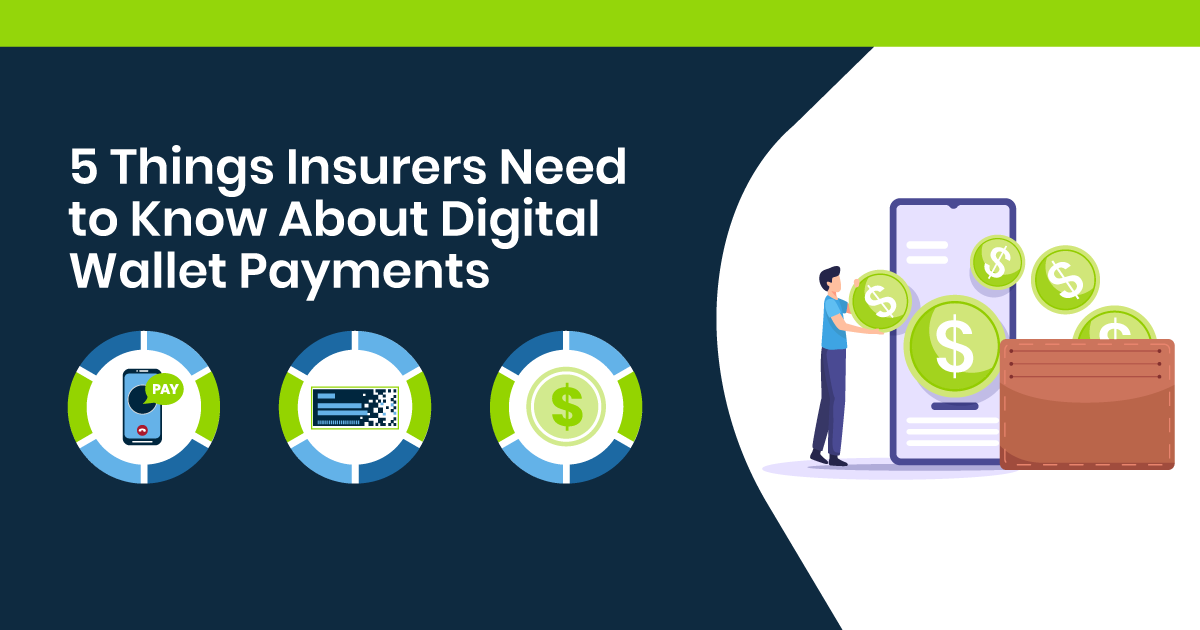
5 Things Insurers Need to Know About Digital Wallet Payments
In March 2020, the Merriam-Webster Dictionary added contactless to its word list1. They define it as relating to or “being a technological system (as for making payments) where information is transmitted without physical contact”.
The sudden rise to fame of contactless payments is also noted by Morgan Stanley Research. They found that every key digital wallet provider, including PayPal, Venmo, and Apple Pay, saw a significant increase in adoption in 2020. The total percentage of consumers using a digital payment service leaped from 70% in 2019 to 78% in 2020. And 40% of those surveyed confirmed they had a payment card stored in their mobile wallets.
These stats reveal why terms like “contactless” and “digital wallet” need to be included in every insurer’s vocabulary right now – especially those intent on delivering an exceptional customer experience. To avoid being left behind, insurers need to be talking about, and finding ways to capitalize on, the many opportunities that digital wallets present.
What is a Digital Wallet?
A digital wallet is an app or cloud-based software that allows a customer to make and accept payments via their desktop device or smartphone without sharing their payment details. It acts either as a storage mechanism for actual funds or as a storage mechanism for payment details (e.g., credit or debit card details, bank details). Knowing that the average American carries four separate payment cards2, it is easy to understand why a single digital wallet on a smartphone, which most people always carry, is fast becoming many customers’ payment method of choice.
Here are 5 things insurers need to know about digital wallets:
1. Digital Wallets Enable Maximum Flexibility
Thanks to cash back and other point-based incentives, consumers have become highly selective about their preferred payment methods. Digital wallets allow customers to instantly choose which payment instruments and accounts they want to use for specific transactions. To remain competitive and increase retention, insurers need to give insureds the payment flexibility that more and more insureds are coming to expect.
2. Digital Wallets Are Convenient
Digital wallets can manage all a customer’s credit and debit cards, boarding passes, and more without adding any bulk to their life. Insurers who can connect with an insured’s digital wallet offer a modern, customer-centric payment experience that is significantly faster and easier than writing a check, filling out a form, or entering a card number.
3. Digital Wallets Improve Customer Experience
When you make it as easy as possible for customers to use their preferred payment method to pay and be paid, you improve your customers’ experience. This naturally results in higher CSAT scores, increased retention, and stronger brand advocacy.
4. Digital Wallets Improve Security
Digital wallets incorporate advanced security solutions like tokenization and biometric authentication to help reduce the threat of fraud. By using a card token instead of the actual card number, a digital wallet solution like PayPal encrypts and secures stored customer information in transit and at rest.
5. Digital Wallets Are the Future of Payments
While the pandemic certainly accelerated the use of ‘contactless’ payments for everyday purchases, it appears that most pandemic-inspired payment habits are here to stay. The Mastercard New Payments Index3 recently confirmed that 68% of people intend to use contactless payments no matter what. A recent Juniper Research study4 predicts that the number of unique digital wallet users will exceed 4.4 billion globally in 2025; up 70% from 2.6 billion users in 2020. These consumers will naturally want to use their digital wallets for all types of payments – including insurance premiums.
Do Not Get Caught Short
Innovative carriers, like Geico, also now allow their insureds to download digital id cards5, which can be stored in an Apple Wallet or on any digital device. Only two states, MA and NH, do not currently recognize digital id cards as valid proof-of-insurance. Every other state allows insurers to download digital id cards and store them in a digital wallet or access them with a click, rather than having to shuffle through a cluttered glove box or handbag to find them.
“Everything is moving towards digital wallets,” notes Chris Ewing, Chief Strategy Officer at One Inc. “Having one central hub for making all kinds of payments without having to pull out a credit card, and having it available everywhere you go, is going to be king. Being able to integrate with those digital wallets is going to be the thing that all of us need to do on the payments side.”
To meet customer expectations, insurers need to modernize their payment capabilities -- fast. The One Inc Digital Payments Platform handles premiums and claims payments, optimizes the user experience with a self-service portal, and accommodates modern payment options. Our single platform offers customers multiple payment methods, including digital wallets like Venmo and PayPal, as well as continuity across payment channels (web, mobile app, IVR, etc.). It also allows insurers to issue payment reversals and provide digital disbursements for premium refunds.
To discuss modernizing your insurance payment capabilities, please call (822) 209-1688 or email inquiries@OneInc.com.
Sources:
1 https://www.merriam-webster.com/words-at-play/meaning-of-contactless
2 https://www.cnbc.com/select/how-many-credit-cards-does-the-average-american-have/
3 https://investor.mastercard.com/investor-news/investor-news-details/2021/Mastercard-New-Payments-Index-Consumer-Appetite-for-Digital-Payments-Takes-Off/default.aspx
4 https://www.juniperresearch.com/press/digital-wallet-users-to-exceed-4-4-billion-by-2025
5 https://www.geico.com/web-and-mobile/mobile-apps/digital-ID-cards/
Tags: Digital Wallet Payments, Digital Wallet
Written by The One Inc Content Team
Want to read more articles like this?

